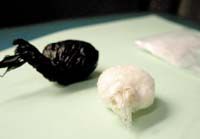| One point five ounces of suspected methamphetamines are displayed at the office of the Carbon Metro Drug Task Force. The local agency reported that they seized this particular stash of drugs at a home in the Price area in August. |
The United States Senate has earmarked more than $2 million in federal monies to assist in battling the meth epidemic in Utah.
During the Oct. 16 session, federal lawmakers approved Senator Bob Bennett’s request to fund programs designed to fight methamphetamine in specific areas of the state.
Examples include juvenile outreach programs geared at attacking meth problems early.
“Utah remains one of the top meth producers per capita in the country,” said Bennett, a member of the U.S. Senate’s appropriations committee. “Fighting this disturbing statistic and epidemic in our state will take a consistent and united effort not only by the government, but by local law enforcement, businesses and schools.”
Since 1998, the U.S. Senate has allocated more than $6.5 million in funding for local enforcement agencies in 23 Utah counties.
The funding helps ease the large burden meth investigations have on the limited budgets of county governments, said Bennett.
“Eastern Utah is particularly susceptible to these problems because of their proximity to major highways known for drug trafficking and the ease of establishing underground meth labs in remote areas,” pointed out Bennett.
Locally, Four Corners Behavioral Health and the county sheriff’s department have discussed the progression and success of Carbon’s felony drug court program.
“Meth along with prescription drugs are the top substances abused by members of the court program,” said Melanie Madill, county drug court tracker. “However, our local program has been very successful as a whole. People always hear about the relapses and the bad things that happen in the program, but no ones notices the successes because those who have succeeded are living normal, quiet, productive lives.”
While local law enforcement and court programs have experienced success, the statistics reported by the governor’s office concerning meth abuse are daunting.
The statistics include:
•Drug abuse was a contributing factor leading to 1,910 children entering state custody during the last year.
Methamphetamine contributed significantly to the drug abuse problem.
•Meth is and has been the number one illicit drug of choice since 2001 for all Utahns admitted to public substance abuse treatment programs.
In 2006 it accounted for nearly 28 percent of the 18,985 statewide admissions.
•Meth is the primary substance of choice for women, accounting for 36.8 percent of all admissions.
“It is the only drug I have ever seen completely take away a mother’s instinct to care for her children,” pointed out Shane Henrie of the Carbon Metro Drug Task Force.
While speaking to a group of local parents about drug abuse, the task force officer said the county is starting to see some decrease in local meth use and the quantity available due to new laws making it difficult to obtain the precursors needed to manufacture meth and tougher border control.
There are currently no laws in Mexico that outlaw the precursors needed to make methamphetamine.
But tough border patrol has made getting illegal drugs across the border a more difficult proposition.
“We definitely aren’t seeing the quantity we were before the precursor laws in our own country,” explained Henrie. “However, due to tight border restrictions we are starting to see labs pop up around the state again.”
To aid in the next phase of Utah’s war on meth, Bennett’s office reported that the U.S. senate’s recent approval of the funding request is another step closer to securing $700,000 in federal revenues to assist Carbon County’s neighboring Uintah Basin law enforcement officials in hiring additional personnel and purchasing meth-related equipment
The meth-related equipment includes body worn transmitters which use radio frequency transmissions to detect human activity at a specific location.
The U.S. senate bill also provides for the purchase of communications devices, surveillance equipment and mobile cameras.
In addition, the bill includes $350,000 to fund Prevention Plus, a program organized by the Brigham Young University-Public School Partnership.
The partnerships is a group consisting of nine public school districts, BYU, Utah State University and the state office of education along with city and state law enforcement agencies.
The program identifies at-risk students enrolled in Utah elementary and secondary schools and uses intervention strategies, support groups and behavioral skills lessons to teach them to make better choices.
According to Bennett’s office, the program has a continuing record of lowering juvenile delinquency.
Methamphetamine abuse has been labeled as the states number one drug problem for several years.
In 2006 Utah Gov. Jon Huntsman developed a joint task force which considers all facets of dealing specifically with the war on the statewide meth problems.
The joint task force and Huntsman supported legislation for improved and continued funding for drug court programs.
The legislation established the Drug Offender Reform Act, which focuses on rehabilitation and protects the real victims of methamphetamine – the children and the families of people using the drug.
Local authorities encourage citizens residing within Carbon County to assist in the battle against meth and illicit drugs by reporting all suspicious activities to the task force at 637-8477.
“Think about the consequences of what you are doing,” concluded Henrie when asked what younger individuals can do when confronted with meth or illicit drugs for the first time. “Think about whether you want to be prison bound, because that is the road I have seen meth take people on. It is an incredibly addictive substance.”

